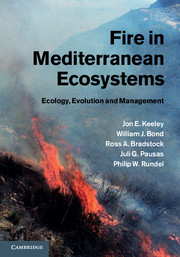2 - Fire and the Fire Regime Framework
from Section I - Introduction
Published online by Cambridge University Press: 05 January 2012
Summary
A global view of potential vs. actual vegetation distributions points to fire as a major driver of biome distribution and determinant of community structure (Bond et al. 2005). In ecological terms, fire acts much like an herbivore, consuming biomass and competing with biotic consumers for resources, and in this sense is an important part of trophic ecology (Bond & Keeley 2005). As in other competitive interactions, not only can fire competitively exclude herbivores by temporarily eliminating resources, but intensive grazing is known to exclude fire by consuming herbaceous ground fuels (Savage & Swetnam 1990). Coexistence is often enhanced by temporal separation of trophic niches, with herbivores grazing early in the spring on green herbaceous material that is unavailable for burning, whereas later in the season the remaining dry thatch is readily consumed by fire. In many respects fire is a more potent competitor because it is not limited by either toxins or protein deficiency and readily consumes dead woody biomass, but by contrast it is often limited by ignition sources and continuity of fuels.
Fire scientists have long symbolized the critical elements of fire in a triangle of fuel, oxygen and heat (Pyne et al. 1996). These are indeed necessary for fire ignition and propagation but are insufficient for predicting the global distribution of fire-prone ecosystems. The conditions both necessary and sufficient to explain the ecological distribution of fire activity can be summarized by four parameters: biomass, seasonality, ignitions and fuel structure (Fig. 2.1). In addition to biomass fuels to spread a fire there must be a dry season that converts potential fuels to available fuels. In mediterranean-type climate (MTC) ecosystems summer drought results in high fire hazard on an annual basis, in contrast to many temperate forests that are only periodically vulnerable to fire in response to decadal or longer oscillations in climate. Vegetation only burns when ignitions are present to initiate the combustion process and landscapes vary markedly in the potential for natural ignitions from lightning, and in the extent of anthropogenic ignition sources. However, understanding the ecosystem distribution of fire requires consideration of a fourth parameter, fuel structure, which is fundamental to recognizing how different fire regimes develop.
- Type
- Chapter
- Information
- Fire in Mediterranean EcosystemsEcology, Evolution and Management, pp. 30 - 57Publisher: Cambridge University PressPrint publication year: 2011
- 1
- Cited by

